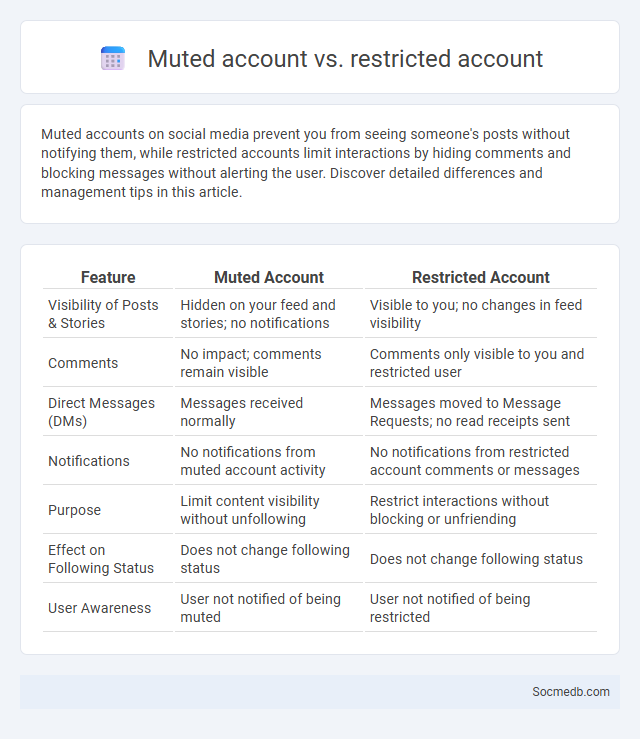
Photo illustration: Muted Account vs Restricted Account
Muted accounts on social media prevent you from seeing someone's posts without notifying them, while restricted accounts limit interactions by hiding comments and blocking messages without alerting the user. Discover detailed differences and management tips in this article.
Table of Comparison
| Feature | Muted Account | Restricted Account |
|---|---|---|
| Visibility of Posts & Stories | Hidden on your feed and stories; no notifications | Visible to you; no changes in feed visibility |
| Comments | No impact; comments remain visible | Comments only visible to you and restricted user |
| Direct Messages (DMs) | Messages received normally | Messages moved to Message Requests; no read receipts sent |
| Notifications | No notifications from muted account activity | No notifications from restricted account comments or messages |
| Purpose | Limit content visibility without unfollowing | Restrict interactions without blocking or unfriending |
| Effect on Following Status | Does not change following status | Does not change following status |
| User Awareness | User not notified of being muted | User not notified of being restricted |
Introduction to Muted, Restricted, and Blocked Accounts
Muted accounts on social media allow users to hide posts from specific profiles without notifying them, creating a more personalized feed while maintaining connections. Restricted accounts limit interactions by preventing certain users from commenting publicly or seeing when you're active, enhancing privacy without full disconnection. Blocked accounts sever all communication, preventing the blocked user from viewing your profile or engaging with your content, ensuring complete control over your social media experience.
What is a Muted Account?
A muted account on social media allows you to stop seeing posts or updates from that user without unfollowing or blocking them, preserving your connection while minimizing unwanted content. Muting helps maintain a clutter-free feed by hiding specific accounts' activity without notifying the muted user. Your social media experience becomes more personalized and manageable through the mute feature, enhancing control over the content you see daily.
What is a Restricted Account?
A restricted account on social media limits the interactions others can have with your profile without them knowing. It allows you to control visibility of your posts and comments, reducing unwanted attention while maintaining connection with the restricted users. You can manage privacy settings to ensure your personal content is protected and your online experience remains secure.
Muted vs Restricted Accounts: Key Differences
Muted accounts on social media allow you to hide posts from specific users without unfollowing or blocking them, maintaining a subtle level of disengagement. Restricted accounts limit the interactions of certain users by hiding their comments from others and restricting their ability to see your activity, offering a more controlled privacy setting. Understanding these differences helps you manage your online presence while tailoring your social media experience to your comfort level.
How Muting Affects Account Interactions
Muting on social media limits visibility of content from muted accounts without severing connections, reducing engagement signals such as likes, comments, and shares. This selective filtering impacts algorithm-driven content delivery, potentially decreasing the muted account's reach and interaction rates. Users maintain follower relationships while curbing unwanted notifications or posts, balancing social connection with personalized content control.
Restrictions: Features and Limitations
Social media platforms impose restrictions on content sharing, user interactions, and data privacy to ensure safety and compliance with regulations. Features such as content moderation algorithms, age limits, and geographical access controls limit how users can engage and what information is visible. Understanding these limitations helps you navigate platforms more effectively while protecting your online presence and adhering to community guidelines.
Privacy and Visibility: Muted vs Restricted
Muted and Restricted settings on social media control your interactions and content visibility differently to protect your privacy. Muting someone hides their posts and stories from your feed without their knowledge, preserving your experience quietly. Restricting limits how someone can interact with your profile, making their comments visible only to them and preventing them from seeing when you're active or have read their messages, enhancing your control over exposure.
User Experience: Impact on Both Parties
Social media platforms shape User Experience by influencing how individuals engage, communicate, and consume content, generating a dynamic environment that affects both creators and audiences. Enhanced user interface design and personalized algorithms increase satisfaction and retention but also raise privacy concerns for your personal data. These dual impacts on social media users and providers emphasize the need for balanced innovation to optimize interaction and protect user rights.
When to Use Mute vs Restrict
Understanding when to use mute versus restrict on social media helps maintain your online experience without unnecessary conflicts. Use mute to quietly avoid seeing posts or stories from specific accounts without alerting them, ideal when you want to reduce content without blocking or unfollowing. Restrict is better when you want to limit interactions and control comments and messages from certain users without their knowledge, providing a subtle way to protect your privacy and manage negative engagement.
Conclusion: Choosing the Right Account Control
Selecting the appropriate social media account control is essential for ensuring data security and brand integrity. Centralized management platforms enhance oversight while minimizing risks of unauthorized access. Businesses benefit from tailored permissions that align with operational needs and compliance requirements.
 socmedb.com
socmedb.com